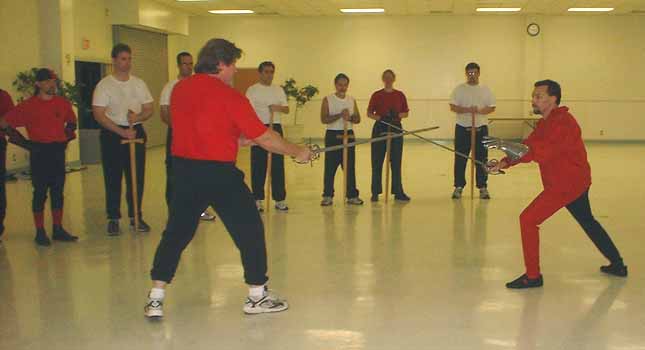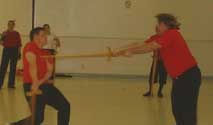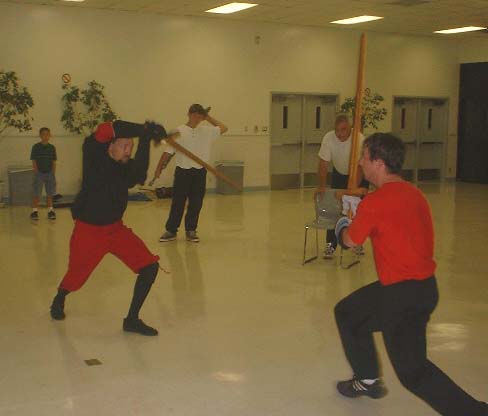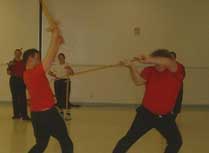By J. Clements
"What is the cause that wise men in
learning or practicing their weapons, are deceived…? …whatsoever they
teach is both true and false;
true in their demonstrations, according
with their force and time in gentle play,
but false in their actions
according with the force & time in rough play or fight."
- George
Silver, 1599
In ARMA's approach to historical fencing we have a philosophy
of teaching and training with "intent." By this we
mean practicing actions realistically in proper range and speed
with the intention to safely make controlled contact.
We believe the only way to communicate authority in any interpretation
of these fighting skills is not by theorizing their application,
but through energetically displaying competence by skillfully
executing techniques in a manner that demonstrates their martial
validity. Indeed, given the frequent misrepresentation and popular
misinformation so persistent in this subject, this is arguably
a necessity.
 It
surely gives no credibility or legitimacy to this subject for
those claiming expertise to fail to perform with expertise.
If techniques or actions are to be established as functional
and effective under actual conditions of violent force, they
must logically be shown-at some point during instruction-with
something more than hypothetical slow motion sequences. Simply
"going through the motions" of a fighting technique
isn't sufficient to either evaluate it or develop it as an effective
action. It is certainly acceptable to move with deliberate caution
and careful control when doing initial analysis, such as when
first teaching new students, or when practicing with novices,
but the eventual goal must be to execute actions with earnest
intent -assuming your goal is actual skill in the reconstruction
of a genuine combative system. The use of controlled force in
this very way is itself a sure sign of higher skill.
It
surely gives no credibility or legitimacy to this subject for
those claiming expertise to fail to perform with expertise.
If techniques or actions are to be established as functional
and effective under actual conditions of violent force, they
must logically be shown-at some point during instruction-with
something more than hypothetical slow motion sequences. Simply
"going through the motions" of a fighting technique
isn't sufficient to either evaluate it or develop it as an effective
action. It is certainly acceptable to move with deliberate caution
and careful control when doing initial analysis, such as when
first teaching new students, or when practicing with novices,
but the eventual goal must be to execute actions with earnest
intent -assuming your goal is actual skill in the reconstruction
of a genuine combative system. The use of controlled force in
this very way is itself a sure sign of higher skill.
 An
instructor of Renaissance martial arts today cannot argue that
techniques can be performed in correct range at proper speed
and timing during sparring/free-play (against an opponent actually
trying to hit you-when you don't know what he is going to do
and who doesn't know what you are going to do), but then also
say they cannot demonstrate or teach the same actions in the
same way under controlled conditions (where your partner is
doing only what you ask). It would be difficult to imagine a
competent teacher in any physical activity, be it martial sport
or martial art, instructing that a student should realistically
practice on their own movements that they themselves cannot
demonstrate, as an example to emulate, in the same realistic
manner in the first place. Students certainly should not be
left to experiment on one another by themselves in how to strike
counter-blows with proper energy. It is a knowledgeable teacher's
very role in this craft to supervise such practice. In fact,
sometimes for beginners moves must be exaggerated during instruction
in order to show the full-action which is executed much tighter
when done at full speed.
An
instructor of Renaissance martial arts today cannot argue that
techniques can be performed in correct range at proper speed
and timing during sparring/free-play (against an opponent actually
trying to hit you-when you don't know what he is going to do
and who doesn't know what you are going to do), but then also
say they cannot demonstrate or teach the same actions in the
same way under controlled conditions (where your partner is
doing only what you ask). It would be difficult to imagine a
competent teacher in any physical activity, be it martial sport
or martial art, instructing that a student should realistically
practice on their own movements that they themselves cannot
demonstrate, as an example to emulate, in the same realistic
manner in the first place. Students certainly should not be
left to experiment on one another by themselves in how to strike
counter-blows with proper energy. It is a knowledgeable teacher's
very role in this craft to supervise such practice. In fact,
sometimes for beginners moves must be exaggerated during instruction
in order to show the full-action which is executed much tighter
when done at full speed.
 Presenting
the core physical mechanics of actions for consideration is
one thing, teaching them with artificiality is entirely another.
To suppose that actions executed in slow motion or at half-speed
respond identically when delivered in earnest at full force
to actually cause injury is illogical. Going slow enough to
learn the basic correct form and fix faults is fine, but if
the error lies in the interpretation of the technique itself
this can only be made apparent when it's applied in serious
practice or free-play. Thus, to justify our understanding of
Renaissance martial arts techniques now we must at the least
show them with safe but realistic energy-meaning in actual striking
range with realistic speed. The historical sources tell us students
training with the weapons of war toughened themselves so that
they could better resist the rigors of the battlefield. Even
in an age before safety masks, rapier masters were said to be
able to "hit any button" -meaning, they could skillfully
land their point on their students with well-placed thrusts.
Neither of these were performed in slow motion.
Presenting
the core physical mechanics of actions for consideration is
one thing, teaching them with artificiality is entirely another.
To suppose that actions executed in slow motion or at half-speed
respond identically when delivered in earnest at full force
to actually cause injury is illogical. Going slow enough to
learn the basic correct form and fix faults is fine, but if
the error lies in the interpretation of the technique itself
this can only be made apparent when it's applied in serious
practice or free-play. Thus, to justify our understanding of
Renaissance martial arts techniques now we must at the least
show them with safe but realistic energy-meaning in actual striking
range with realistic speed. The historical sources tell us students
training with the weapons of war toughened themselves so that
they could better resist the rigors of the battlefield. Even
in an age before safety masks, rapier masters were said to be
able to "hit any button" -meaning, they could skillfully
land their point on their students with well-placed thrusts.
Neither of these were performed in slow motion.
 Practicing
with intensity does not mean just using strength or speed either,
for learning to effectively deliver techniques, enthusiasm is
no replacement for experience-i.e., the precision gained from
well-practiced movements. In reconstructing and interpreting
the methods of extinct combat arts today we must also be ever
careful to be sure we actually are re-developing skills that
would work for real-against unskilled beginners as well as well-trained
and experienced opponents.
Practicing
with intensity does not mean just using strength or speed either,
for learning to effectively deliver techniques, enthusiasm is
no replacement for experience-i.e., the precision gained from
well-practiced movements. In reconstructing and interpreting
the methods of extinct combat arts today we must also be ever
careful to be sure we actually are re-developing skills that
would work for real-against unskilled beginners as well as well-trained
and experienced opponents.
Yet, a student might reasonably ask, "But what if I concentrate
my practice on a lower level of intensity, one that suits me,
is enjoyable, and seems more than adequate for learning and
practice?" The question is a legitimate one and the answer
is that such effort is certainly both acceptable and even warranted
in the learning process of a combative system, so long as the
virtue and historicity of training at higher levels is also
recognized and appreciated-as the means by which we come to
know what is combat effective. Further, we must reject the notion
that any student of this subject is incapable of or unsuited
to pursuing it as a legitimate martial art with energy and intent
and instead has to be resigned only to role-playing and pretend
performances. Such a pessimistic view is condescending and insulting
to both enthusiasts of historical fencing and to our heritage.
The techniques of Renaissance martial arts were meant to protect
an individual from being attacked with deadly speed and force.
Historically, it was imperative they were understood within
this context and they were surely taught to students in this
way. When practiced out of a necessity for men to survive deadly
encounters would these skills have been learned any other way?

